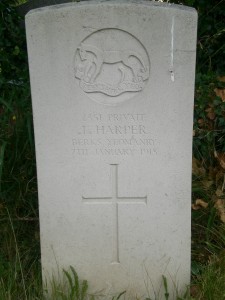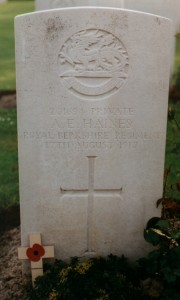Francis John Harper
Private 2351
1st/1st Berkshire Yeomanry
Division 24
Francis J. Harper was aged 32 when he died. He had been a member of the Berkshire Yeomanry for 12 years, resigning some years before the war at the rank of sergeant. When war broke out he re-enlisted as a trooper (the equivalent of Private) and would have been entitled to be promoted because of previous experience. He contracted a severe chill at Bear Wood whilst training and was brought to the Royal Berkshire Hospital where he died on the 6th January 1915 from double pneumonia.
The military funeral was attended by 140 officers and men of the Yeomanry, employees of Mr J. White, Castle St., staff from Whitley Special School, his brother Mr W. Harper of 102 Radstock Rd. himself an old Bucks. Yeoman, his sister and widowed father. A detachment of men from Bear Wood followed his flag draped coffin to the grave, over which the customary three volleys were fired.
There was a wreath from the children of Whitley Special School, whom he used to drive to and from school. The Standard reported that the children had the kindest regard for Mr Harper, who when he enlisted received a letter from the physically defective pupils saying –
Dear Mr. Harper,
We are all very glad to hear you are going to the front, but we are very sorry to have to say good-by to you. We hope you will someday return safely, and come back to drive our carriage once more. We have collected just a little money and we hope you will buy something you like with it. The socks are knitted by the girls. Thanking you for all your kindness to us.
Yours sincerely the Children of P.D.SIDE
P.S. Will you please let us know where you are stationed so that we may write to you sometimes.
Francis John Harper is interred in a Registered War Grave with a war pattern headstone.

